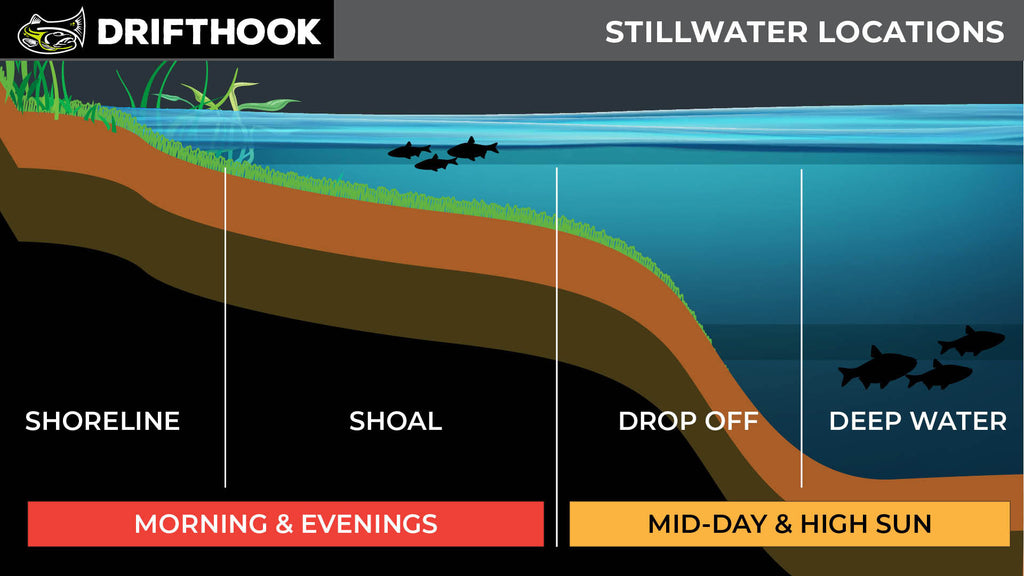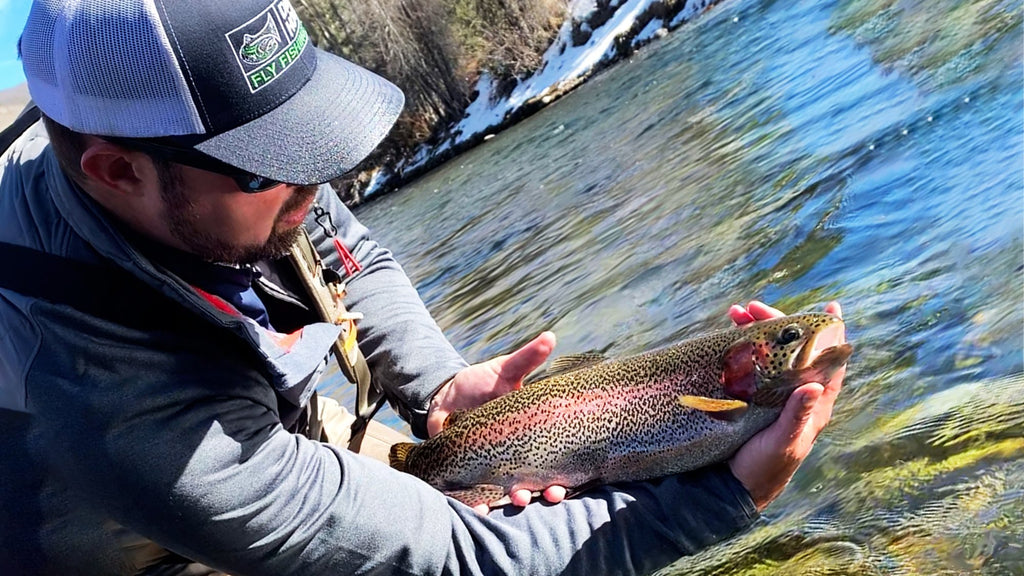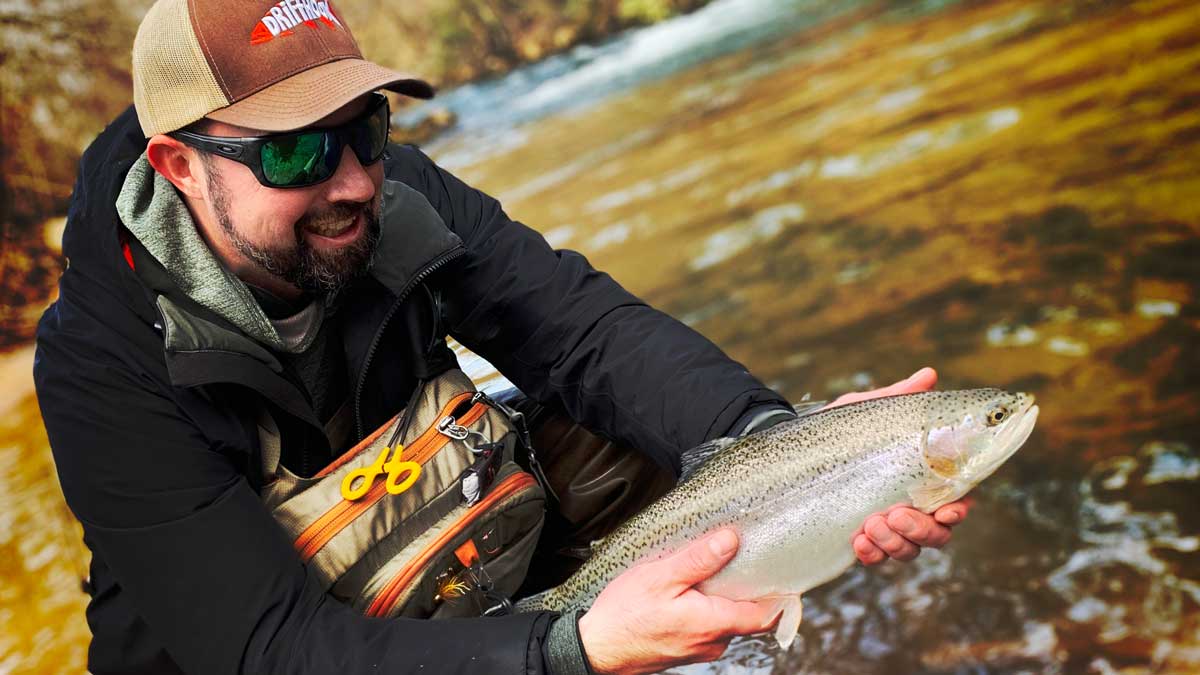When going on a fishing trip, the ideal would be to locate the fish as soon as possible to ensure a successful experience. Reading the water means using different techniques and knowledge that enable you to determine where the most fish lie accurately. In this article, you'll learn everything you need to know to successfully read the water and find fish more effortless than ever before.

How do I read water when fly fishing?
Fish are always looking for one of two things - a safe shelter from predators or a source where they can find food quickly. Reading the water means identifying where fish go for these two things. Experts say that only around 10% of a water mass has fish, so pinpointing where the fish lie and feed will largely determine your fishing trip's success. To determine where the fish are, you can look at three different spots where they'll most probably nest:

1. Shelter/nesting area
Fish, especially rainbow trout, usually seek shelter in deeper water - this allows them to stay hidden and stay beneath the strong current above. They can also be found in undercut banks and even behind rocks where the current is slower.
2. Feeding Lanes
The feeding area is usually somewhere where there is a strong current allowing the food to come to the fish - this helps them save energy on needing to actively search for food and provides an opportunity for them to reach more food in shorter periods of time.
3. Holding ground
Trout find holding grounds in areas where the current isn't as strong, allowing them to stay put with minimal effort while waiting for the food to come to them. You can find these grounds in front or behind a rock that's breaking the current, allowing the stream around the rock to bring the food to them.
Where do I find these spots fly fishing?
To find the above locations optimal for trout to feed and lie, you need to find what they call seams. Seams are formed when water hits a rock or any other object that disrupts the current, creating a slower stream where trout can find shelter and food without using too much energy fighting the current.

These seams are your best chance of finding and catching trout, seeing as the seam is the one spot where the fast- and slow-moving water is right next to each other - creating the perfect place for the fish to nest as well as feed.

Apart from finding the right location for your fly fishing outing, there are still a few aspects to consider when it comes to successfully reading the water to find some monster trout! Have a read further on to acquaint yourself with some more useful tips.
Where do I find the seams?
There are multiple locations in the river where you can position yourself at a seam that will give you optimal results and loads of trout. Depending on your preference, each one of the options listed below can give you an advantage and place you in just the right place to make your fly fishing day one to remember.
1. Rock seam
Rock seams are the easiest to start with if you're a beginner. That said, there are a few different positions you can place yourself to catch some rainbow trout - the first is the back seam located at the back of the rock.

Using this seam will allow you to cast your fly and watch it drift in the current, right where the trout go to feed. You can also try the front seam, also called the pillow seam, where the water hits up against the rock, slowing the current down immediately. This is where trout like to hold back and wait for food to come to them, so it's also a great option.
2. River bend seam
This is one of the most fun positions to choose when fly fishing - you can also cover a lot of ground in a short amount of time. Lots of trout are found in a river bend seeing as this is also one of the spots where the water slows down just enough for them to hang out in.

So, if you'd like to make a day out of your trip, this is a location to consider seeing as there will never be a dull moment.
3. Head of a Pool
In the pool area of a river, you will find the head of the pool and the tail of the pool. The head of the pool is where the fish are feeding, seeing as the head of the pool is where the fast-moving water slows down just enough for the trout to get some food.

4. Tail of a Pool
The tail of the pool is where the water, almost like the head of the pool, slows down enough for the fish to be able to pop out of their shelter just long enough to grab a quick meal and head back.

5. Undercut embankments
These are quaint little hiding places for trout, keeping them safe from predators and allowing them to stay out of the strong current but still close enough so they can pop out for a quick meal when needed. Undercut embankments are great places to cast your fly and just let it hover for a long as possible. Make sure you also get as close as you can when approaching this method.

How else can I read the water except looking for seams?
When standing by a river, have a look at the depth of the water. If the water is clear, look at areas where there are darker spots - this means that there is a depth change in the water, seeing as deeper areas appear darker. The deeper regions are where the trout are because the darker water provides more coverage and hiding place.

But, don't be fooled completely. Shallower water may be empty during the day, but at night is the most likely area where trout go to get food as they have the element of darkness to protect and camouflage them. This means that you have to read the water depending on the time of day as well as the season.
In the winter, the water's cold temperatures slow down the fish's metabolism, which will cause them to seek shelter somewhere they don't need a lot of energy - this is when you should look for them in deeper holes where the current is much slower. But, in the summer, trout like to move to spots where feeding will be much more comfortable, such as the shallower water and the seams mentioned earlier.

Read the Water Pick the Fly - Fly Fishing Flies for Trout
The fly line setup you should use depends entirely on the size of the fish, where you're going to cast your line, and the type of pressure the trout is under. The poundage fly you're going to use also called the "X" Size, is determined according to the size trout you're looking to catch.

When fishing in moving water, try using more than one fly at the end of your line - this is also called a two-fly nymph. This will double your chances of success. You can adjust the weight of your fly depending on the depth of water where your fishing.

You'll also figure out what color fly the fish prefer that day very early on and the methods you should use. The multiple nymph setup mentioned above works great for general use when fly fishing. That said, the structure usually looks like this:
- 9ft 4x leader
- Clear bobber indicator
- Splitshot – 2 to 3 size 4
- Fly #1
- 12" to 14" 5x or 6x tippet
- Fly #2
If you're looking at catching some monster trout that are under lots of pressure, a different approach might work better, such as a 90-degree setup. This rig places the fly right in front of the trout's mouth when the line has been cast.

By doing this, you'll catch the monster trout's attention right away if the fly is facing directly down. This particular setup will look more like this:
- 2ft to 15ft 0X or 1X leader or 40lb Mono if you're building your own leader
- Clear bobber indicator with a perfection loop
- #14 Swivel
- 6ft to 7ft of 6x or 5x tippet to the first fly. Tie fly on with the Improved Clinch Knot
- Split shot 12" to 16" above the first fly (add as needed depending on depth)
- 12" to 14" of 5x or 6x tippet to next fly
- The second fly tied with Non-Slip Loop Knot
If you're fly fishing in very murky water or really deep pools, two flies may not be enough to get the job done. After making sure that local fishing laws permit it, try adding a third or fourth fly to your line to maximize your success chances.
This will also enable you to determine which fly works best for the trout accurately. This technique is called a drop shot line setup because by using larger patterns and heavier tackle, the weight will drop into the water and lead the pattern and hook above it. Using this technique will require a setup similar to this:

- 8ft Leader 4x or 5x
- Clear indicator
- Weight on the bottom
- Overhand Knot, connect fly with a dropper loop
- Overhand Knot, connect fly with a dropper loop
- Keep Flies 8" to 12" apart
How to Read Still Water - Fly Fishing in Still Water
Also, similar to fly fishing in a river, you have to read the water and know where and when to go to which part of the water. Trouts like to move around together in a lake, so where there weren't any fish before in a particular area, there may be a boatload later on.
But, it is also crucial to find spots where they like to hang around - this will include reefs, inlets, and drop-offs. These locations should be the first place you go to, seeing where the trout will go for food.

Also, watch what's going on around you. For example, it would be a good idea for you to run like the wind towards an area where you see lots of insects flying around or birds diving to catch them.
Be sure also to know that every lake is different. Some are deeper than others, some are clearer than others, and every lake has various nutrients and minerals in the water itself.

How to Fly Fish in Still Water
Down below, you will find the most straightforward steps to follow when fly fishing in still water. The instructions will show you some techniques that will come in handy and what you should look out for when fly fishing, what the different signs are to observe closely, and the rigs needed to increase your chances of success.
By following these steps, not only will it be an exciting and adrenaline-filled fly fishing experience, but you'll be well acquainted with everything you need to know regarding the process.
1. Find the most optimal depth
What you need to do first is find the perfect depth to cast your line. Look at the water's temperature, which will give you a good indication of the chances of there being any trout. They like temperatures that average to about 13 degrees celsius / 55 degrees Fahrenheit and swim more alongside the surface areas where they can find more food.

2. Get the correct fly
The perfect fly is crucial to getting the trout's attention. The first of a few ways to make sure you have the right fly is to look at what insects you can use - trout usually like to feed on insects. Make sure you have a wide variety of flies available so that you'll be prepared for whichever size insect you find.

3. Find the perfect location
Once again, the temperature of the water is of paramount importance to determine whether there will be any trout in the vicinity. Although they move to the center of the lake when getting food, they like to stay close to rocks and other obstacles most of the time, especially when the water's temperature is lower. When testing different areas, don't bother hovering for more than 15 minutes if there are no trout signs.
4. What attracts the trout?
Please acquaint yourself with what it is that causes trout to take the bait. By doing this, you'll be more comfortable and confident when you go fly fishing for trout in still water. Different flies with different shapes and sizes can have a massive impact on whether the trout get attracted. Trout are pretty quick on picking up any changes, so be sure to use the correct fly as early on as possible.
5. The fan casting approach
This is a much more knowledgeable way of trout fishing and will benefit you in the long run. Using the fan casting approach, you will cover more ground by casting from a different angle each time. This will ensure that you attract trout from all the other areas when fly fishing.
6. Catch the fish
By doing the above and following each step methodically, there is no doubt that you will have an epic fly fishing experience. Remember to pull the line in to secure the hook safely in the trout's mouth. Afterward, wait for the trout to get tired and reel in slowly while keeping the fish tight on the fishing line - remember to get the net out and place it in the right position.

All of the steps above are guidelines to not only have a successful fly fishing experience but to understand what's going on at all times, why things happen the way they happen and why trout behave the way they do.
Fly fishing is ultimately a game of patience and endurance but can be revitalizing for the soul when allowing yourself to enjoy it thoroughly.
That said, there are a few key takeaways from this article that you should remember and spend time on, such as learning to read the water correctly to optimize your chances of catching some monster trout. Flies are also essential for the success of your outing - different flies are for other techniques and rigs, and you should always have a wide variety of them on hand, ready for any situation.

Remember to check the water's temperature where you are planning on fly fishing for some trout - the better the temperature, the more fish there will be in the vicinity!
Lastly, remember to take in every moment of your fly fishing experience. Every trout that is caught is a reward for your hard work and patience, and every failed expedition is not a failure but a learning curve that can help you understand fly fishing even better!
In the end, fly fishing is a means of enjoying yourself, making memories that you'll never forget, and appreciating nature and everything it has to offer.

Matthew Bernhardt, a third-generation Coloradan, grew up at the forefront of the state’s fly-fishing revolution, enjoying time on the water, side by side with experienced guides and lifelong anglers.
By combining his passion for fly-fishing with input from other experienced fly-fishers and guides and his fine arts degree from Colorado State University, Matthew spent five years carefully developing the Drifthook Fly Fishing System, built to help every angler catch more trout.
When he’s not spending time with his wonderful family, you’ll find him out on the water catching MONSTER trout, and he anxiously looks forward to the day when his kids are old enough to join him there.







